Robert Knox's Blog, page 29
June 26, 2017
Alice Munro's Universal Stories
Family Furnishings by Alice_Munro:
Alice Munro is a Nobel Prize winner (move over, Bob Dylan), but I'd only read her stories occasionally in The New Yorker. A year ago I was recovering from surgery and needed a long book. This collection of stories fit the bill. And if it were twice as long I might still be reading it. All her stories, or almost all of them, feature a young woman brought up somewhere in rural Canada, who knows she's different from the most of the people in her world, and won't be happy unless she tries to do something in a larger world. Characters run through Toronto a lot. Sometimes they go home again, with a baby, or a husband, or an attitude. But you can't go home again. Your parents have changed. Your father, a teacher when you were growing up is now selling vegetables, and is obsessed with a young woman who's 'handy' around the farm. Your mother is halfway to Alsheimer's. They're not what they used to be. Nothing is. Some of the stories begin well before World War II. A man who does not want to be a farmer like everybody else finds he has the knack for raising minks for the fur market and makes a life of it. But his wife turns to be the better marketer. When their daughter returns home, decades later, he's working in a factory instead. Where are all the animals, Dad? You used to be your own boss.... But things don't turn out the way you expect. Sometimes, the stories change up and begin with a young man. He's riding a train (Canada is all about trains) home to a small town after the war. He gets off the train early on a whim, discovers a decaying old farmstead that needs work, agrees to stay a few days to patch a roof, or fix something else for the woman who lives by herself. There's always something else to do, and in the end he never does make it home. A married couple -- she's naive and vulnerable, he's manipulative and difficult -- run a riding stable in the country, but the weather is bad, and the husband is picking fights with his business associates. Unhappy young wife conspires with a well-off older neighbor to run away to the city (Toronto), but she loses her nerve when she cannot imagine how she will manage alone when she gets off the bus and goes back to the controlling husband.
One way or another, nobody gets actually what they want, or not what they think they want. But they all learn something along the way, and so does the reader. This may seem a restricted canvas -- nobody here lives in New York or California or London or the Third World -- but readers will recognize themselves and the people they know in these characters, their situations, and their relationships with others. Munro's theme is universal. It's how we live with ourselves.
View all my reviews
Alice Munro is a Nobel Prize winner (move over, Bob Dylan), but I'd only read her stories occasionally in The New Yorker. A year ago I was recovering from surgery and needed a long book. This collection of stories fit the bill. And if it were twice as long I might still be reading it. All her stories, or almost all of them, feature a young woman brought up somewhere in rural Canada, who knows she's different from the most of the people in her world, and won't be happy unless she tries to do something in a larger world. Characters run through Toronto a lot. Sometimes they go home again, with a baby, or a husband, or an attitude. But you can't go home again. Your parents have changed. Your father, a teacher when you were growing up is now selling vegetables, and is obsessed with a young woman who's 'handy' around the farm. Your mother is halfway to Alsheimer's. They're not what they used to be. Nothing is. Some of the stories begin well before World War II. A man who does not want to be a farmer like everybody else finds he has the knack for raising minks for the fur market and makes a life of it. But his wife turns to be the better marketer. When their daughter returns home, decades later, he's working in a factory instead. Where are all the animals, Dad? You used to be your own boss.... But things don't turn out the way you expect. Sometimes, the stories change up and begin with a young man. He's riding a train (Canada is all about trains) home to a small town after the war. He gets off the train early on a whim, discovers a decaying old farmstead that needs work, agrees to stay a few days to patch a roof, or fix something else for the woman who lives by herself. There's always something else to do, and in the end he never does make it home. A married couple -- she's naive and vulnerable, he's manipulative and difficult -- run a riding stable in the country, but the weather is bad, and the husband is picking fights with his business associates. Unhappy young wife conspires with a well-off older neighbor to run away to the city (Toronto), but she loses her nerve when she cannot imagine how she will manage alone when she gets off the bus and goes back to the controlling husband.
One way or another, nobody gets actually what they want, or not what they think they want. But they all learn something along the way, and so does the reader. This may seem a restricted canvas -- nobody here lives in New York or California or London or the Third World -- but readers will recognize themselves and the people they know in these characters, their situations, and their relationships with others. Munro's theme is universal. It's how we live with ourselves.
View all my reviews
Published on June 26, 2017 21:14
•
Tags:
alice-munro, canada, family-stories, nobel-prize, universal-themes
June 22, 2017
The Garden of Verse: Where Do the Poems Come From?
 Poets in the June 2017 edition of Verse-Virtual took on the mystery of where poems come from.
Poets in the June 2017 edition of Verse-Virtual took on the mystery of where poems come from. "Writing the Poem," a fabulous poem by Dick Allen (fables galore in here), is a bravura response to the never-stated theme of writer's block. The answer? You let the poem write itself. Things just happen, but they happen in so lively and picturesque, and unexpected, a way that the reader can't wait to see what happens next:
".... The poem
will start singing 'One bright morning, I’ll fly away'
or jump from a Walmart roof...
the poem will make friends with furniture salesmen,
and eat avocados just arrived from Monday." I'll take my avocados from Monday any day of the week. I liked every high-jumping, sky-dying line here, but I also wish to pay special mention these:
"Poet naïf, poet of the corner store
with your mind set upon camera lenses and canary yellow,
are you in your right mind?" 'Poet of the corner store' strikes me as a marvelous image. Next time I go to the corner store, I'll try to see where it takes me.
This is a poem that demonstrates by its own construction where poems come from. Sometimes the 'wrong' mind might be the right one.
The mystery of inspiration wafts over some other poems I admired in June's Verse-Virtual. CJ Clark introduces us to the enigma of the Skogmo Cafe, accompanied by a black-and-white photo that made me think "JFK." The poem asks, "Wasn't this once called the Skogmo Cafe?" Neither party knows the answer.
"Instead we order soup
And sip the chowder, the broth
Of our separate winters..." I love this poem for the image of spooning up "the broth
Of our separate winters..." Not the bread of affliction, nor the shortcake of romance, yet a piquant and, I suspect, highly personal taste.
I don't know the "Line From Merwin" alluded to by the title of Judy Kronenfeld's poem, but I don't need to in order to feel myself surrendering to the sensations of ephemeral beauty and sorrow evoked by the language of this poem. "Each day on the long drive home
how easily the sky
soars into profundity,
like silent music." The profundity of "silent music"? Another mystery, perhaps But we probably know in our own hearts what the phrase means. This is a poem built on short lines of exactly right words.
Jim Lewis offers a wise and clever interpretation of a painting by Firestone Feinberg (pictured above) in "the color of your songs." The poem repeats lines, or parts of lines, from the end of one stanza to the first of the next, echoing the repetition of imagery in Feinberg's paintings. I particularly admire the alliterative music in this stanza that renders the whole more playful in tone than a literal summing up of 'meaning' could possibly do: "sonata for serpent
where bass clef crawls
along the floor
and treble spreads its trouble
all across the couch cushions
below watchful eyes..."
Joan Mazza's poem "On Being Asked How I Write a Poem Every Day" provides another answer to the question posed implicitly by the theme of a writer's block. Like some of these others, it's a poem that demonstrates in its own creation the 'point' it appears to be making. The way on, the poet tells us, develops from a seamlessly sustained comparison for working a vein and digging in an earth that is always there: "Some days I wear a hat, boots, and work gloves,
and push the wheelbarrow over logs and mud,
ruts and roots that trip along the way..." We all know about that mud, those 'ruts and roots' (two words that call to one another). And if there are indeed logs lying across the floor of your personal forest, you have my deepest sympathies. I have entered such forests and gone nowhere in them. But Mazza's poem takes us swiftly to black soil "under old oaks," and we sigh with remembrance and know that we're onto something now. June V-V is onto something too. It's simply more fine poetry. These poems and many others can be found at http://www.verse-virtual.com/poems-an...
Published on June 22, 2017 21:04
June 20, 2017
The Garden of the Irrational: What 'Julius Caesar' Tells Us About Killing the Hero of the Masses Who Would Be King
 Julius Caesar may look to some people like POTUS No. 45, but his enemies were not 'democrats' (large D or small).
Julius Caesar may look to some people like POTUS No. 45, but his enemies were not 'democrats' (large D or small). Democracy -- from the Greek word 'demos,' meaning 'the people' -- is the belief in rule by the many, as opposed to the few. A democrat, therefore, has always been the term for someone who believed in that theory. But the word people like Caesar, in Caesar's Roman Republic, used for the people was "the mob." The common people are easily swayed, so the Roman upper class believed. And that is their role -- mobbish potential turning into actual mob mentality and mob violence -- in Shakespeare's play "Julius Caesar." The Roman Republic appointed "Tribunes" to be the spokesmen for the people's interests. In Shakespeare's play, the Tribunes oppose the movement to make returning war hero Caesar into some sort of dynastic monarch: a ruler with a crown. A crowd of plebs (the Roman term for the common people) seeking to fawn over Caesar and give him dictatorial powers is denounced by one of the Tribunes as "you clods, you blocks, you worse than senseless things." Caesar actually holds the office of 'consult,' or 'chief executive' in the Roman government. The Roman Republic elected two consuls at a time, so they could keep an eye on each other, and their term lasted only one year. The supporters of Caesar's elevation to some kind of kingly sovereign-status are not looking for commoners' vote. The plebs don't vote. Caesar's party is looking for traditional form of commoner support, as understood in Classical times -- mob rule. A big city riot provides good cover for a coup. Politically, Rome was a 'republic' in the Classical meaning of term; before it turned into a world-dominating empire. A republic means a government with an elected head: those consuls. But real power lay in the Senate. The Senate elected the consuls and appointed the generals. But the Senate was not itself an elected body. It was an exclusive club you joined for life when (here's the fun part) you had accumulated a million dollar -- more accurately to the period, one million 'sesterces.' But I love the notion that Romans were hung up on the idea of 'a million.'
Even back in pre-capitalist Rome people believed that power came from money. So in some ways the Senate was closer to what we call an 'oligarchy,' a body of wealthy property owners the Romans called 'patricians.' The body's importance is conveyed in the republic's abbreviated signature for the Roman state: SPQR. Senatus Populous-Que Romanus. 'The Senate and the Roman People.' The ambitions of some Patricians however were too big to be contained by the Senate -- men such as Caesar and Pompey, a pair of victorious generals with a naked will to power. Talk about political factions and polarized parties. These two ended up embroiling Rome in a civil war. When Caesar won, his party argued 'let's just put an end to all this destructive political in-fighting and make Caesar 'king.' "Anthony offered him a crown," Casca tells Brutus in Act I, Scene ii of Shakespeare's play. "(Caesar) refused it the third time, and as he refused it the commoners hooted and clapped their chapped hands, and threw up their sweaty hats, and let loose such a great deal of stinking breath because Caesar refused the crown that it nearly choked Caesar..."
In times of trouble the Romans had a habit of seeking to turn their heroes into kings. When the Roman farmer-general Cincinnatus left home and hearth at a time of great danger to lead an army and save his country from an enemy, a grateful populace tried to make him ruler. But Cincinnatus won lasting fame by waving off the offer and going back to his plow. This conduct is the model for what later centuries called "republican virtue," the willingness to sacrifice personal good for love of country, but to seek no glory for oneself. It is the model George Washington invoked when his soldiers sought to turn him into a a ruler -- tyrant, king -- at the victorious close of the Revolutionary War. Washington said no thanks and went home. Years later he again answered his country's call and agreed to become the new nation's first President; but after two terms he said, that's it, I'm done.This country is not about one man, not even George Washington.
The politician-general known to history as Caesar has already fallen a good deal short of this standard when Shakespeare's play begins. In fact, Caesar wants the crown -- but he wants it not just from the plebs, but from the Senate.
We see him in scenes subsequent to his pretense of turning down the crown offered by Anthony already acting like a monarch, speaking of himself in the third person, listening to petitions for favors from members of his own class. We hear Brutus, 'the noblest Roman of them all,' agonize over how to preserve the republic from the danger of tyranny. I have nothing against Caesar, Brutus reasons, but what if all this new power people desire to give him causes him to change. In short, power corrupts.
I know no personal cause to spurn at him
But for the general. He would be crowned.
How that might change his nature, there’s the question.
It is the bright day that brings forth the adder
And that craves wary walking. Crown him that,
And then I grant we put a sting in him
That at his will he may do danger with.
Following this logic, Brutus -- the natural leader of the 'Republican' wing of Rome's political class and the true central figure in the play -- decides to join the conspiracy to assassinate Caesar before Roma gives him the absolute power of rule that kings, emperors, pharoahs and brigands enjoyed everywhere else. It's hard to read (or hear) Brutus's soliloquies without sympathizing. He's the play's sympathetic character. However, the act of political assassination by itself leads to even worse consequences than Brutus fears from one-man rule. Violence is like that. "They that sew the wind shall reap the whirlwind." The consequences, in Shakespeare's play, include mob riots whipped up Caesar's followers against the conspirators, killings in the street, the murder of innocent bystanders. Then the division of the country in yet another civil war. And finally the ultimate defeat of the republican faction and the death of its leaders. Brutus takes his own life. Nobody who has read or seen this play to its end is likely to conclude that it makes a good case for assassinating a dangerous political tyrant. The would-be tyrant you kill paves the way for a still more capable tyrant to come. That's what happened to Rome. Caesar was followed by his grand-newphew, Octavius Caesar (known to history as Caesar Augustus) as the first Roman emperor. While Julius Caesar was a successful general and an ambitious politician, Octavius was the cold-blooded CEO of an empire built and maintained by reliance on force. Crucifixions were a specialty. Rome was never a republic again. Works of art such as Shakespeare's plays are not propaganda. They're not prescriptions for behavior or incitements to a certain action. They don't necessarily have any moral that can be explicated in a sentence or two. What they do is enable and encourage human beings in any society to confront in the realm of the psyche and the imagination -- (the soul, perhaps) -- issues, ideas, questions and crises similar to those they experience in the cold light of their own reality. "Julius Caesar" cannot tell us, and doesn't try to, how to act in the deplorable era of POTUS No. 45. It does offer some warnings, based on the history of a famous long-ago republic that served as thought-provoking precursor to the thinkers who established a constitutional republic in the United States. But what we choose to do, and how we think about our situation, is still up to us.
Published on June 20, 2017 20:53
June 15, 2017
Gardens and Verse: On the Reasons, and the Seasons, for Writing About Your Own Home Garden.


I've written about this subject before. Quite a bit actually. Recently, however, I was following a National Poetry Month poem-a-day program that offered an interesting prompt on the subject of land use. And one which invoked one of the oldest traditions of poetry in Western Civilization. The prompt called for writing a "Georgic," that is, a poem dealing with practical aspects of agriculture and rural affairs. This is the subject for a major poem by Virgil, generally judged the greatest of the Latin poets, titled "The Georgics," a term drawn
from the Greek word “Georgicon.” I never studied the Greek language, so I'm relying on secondary sources for an idea of what Virgil was up to. According to the Ancient Literature website, “Georgicon” translates to "agricultural things." A Georgic, I'm told, is a didactic poem in the tradition of the Greek writer Hesiod, and the ostensible subject of the verses is rural life and farming. "Part farming manual, part hymn of praise, part allegory ['The Georgics'] contains some of Virgil's finest descriptive writing, with patriotic overtones and rich mythological allusions." In the third and last part, however, Virgil wanders off from a discussion of bee-keeping to give readers an account of the story of Orpheus and his attempt to rescue his beloved Eurydice from the underworld. The tale is one of those unforgettable myths that human beings in succeeding centuries, countries, and civilizations keep coming back to. The agricultural (or pastoral) subject material of Virgil's great poem called to poets writing in English many centuries later. English poets in the 18th century wrote their own "Virgilian styled Georgics and country themed pieces with an emphasis on withdrawal from city life, the rustic arts, and an embrace of a happy life on the country estate," according to the Wikipedia. And yet again in the early 20th century, the term "Georgian poetry" was applied to the work of lyrical poets who "took inspiration from the countryside and nature," including Hilaire Belloc, Edmund Charles Blunden, Rupert Brooke, William Henry Davies and Robert Graves. Among these, Brooke and Graves are still widely read, though the tag 'Georgian' came to be applied to merely conventional, backward-looking writing and was widely applied as a pejorative term. Well, we can't have that. I'm happy to take on the role of restorer of the "Georgic" in contemporary verse. And since the only form of 'agriculture' I know anything about is the style practiced in residential backyard (and front yard) gardens -- as you may just possibly have heard me say before -- here's my introduction for the kind of poems collected in my recently published chapbook "Gardeners Do It With Their Hands Dirty."
 Many of the poems in this book, especially those that relate to its title "Gardeners Do It With Their Hands Dirty," spring from a decision, following our move to a house with no garden and precious little lawn to dig up all the turf grass on the property and plant flowers, perennials, ground cover, shrubs, a small tree or two, berry bushes, potted annuals, and vegetables. My first title for poems about the garden project was "The Amateur." From its Latin roots -- the word means "lover." I have no training, no claim for expertise, I'm not a professional -- I don't even belong to a garden club -- I just began digging things up and planting. So, to be an amateur means to do something not for money, but for love, or desire. We hired a company to remove the surface, level the earth, add topsoil (which they didn't). Then Anne and I laid out a design, I spend a lot of money (for us) in a garden shop, and we started digging. And planting -- sort of, before we realized how little soil we had. We had truckloads of soil dumped on our parking area and then transported it by wheelbarrow to the planting beds. Then came more digging. Then some more planting. We laid out brickwork paths. Our plants grew, most of them were successful from the start. It took a few years for the plantings to fill the spaces. I loved the development stage. I like learning by doing things, and try to learn from experience. I love to see things growing. I love the idea that when we step outdoors, we are in nature. The "environment" begins at the doorstep. Open the door; breathe the air; listen... One day a cardinal sat on the head of a sunflower, bobbing and calling, looking for all the world as if he had just lost something. (A mate?) I noticed he ate a few sunflower seeds while he was there too. There is always something to see...
Many of the poems in this book, especially those that relate to its title "Gardeners Do It With Their Hands Dirty," spring from a decision, following our move to a house with no garden and precious little lawn to dig up all the turf grass on the property and plant flowers, perennials, ground cover, shrubs, a small tree or two, berry bushes, potted annuals, and vegetables. My first title for poems about the garden project was "The Amateur." From its Latin roots -- the word means "lover." I have no training, no claim for expertise, I'm not a professional -- I don't even belong to a garden club -- I just began digging things up and planting. So, to be an amateur means to do something not for money, but for love, or desire. We hired a company to remove the surface, level the earth, add topsoil (which they didn't). Then Anne and I laid out a design, I spend a lot of money (for us) in a garden shop, and we started digging. And planting -- sort of, before we realized how little soil we had. We had truckloads of soil dumped on our parking area and then transported it by wheelbarrow to the planting beds. Then came more digging. Then some more planting. We laid out brickwork paths. Our plants grew, most of them were successful from the start. It took a few years for the plantings to fill the spaces. I loved the development stage. I like learning by doing things, and try to learn from experience. I love to see things growing. I love the idea that when we step outdoors, we are in nature. The "environment" begins at the doorstep. Open the door; breathe the air; listen... One day a cardinal sat on the head of a sunflower, bobbing and calling, looking for all the world as if he had just lost something. (A mate?) I noticed he ate a few sunflower seeds while he was there too. There is always something to see...My latest offering on this subject, currently up on the June Verse-Virtual, reverts to the theme of what to do with our own good patches of earth, though in a more baroque, occasionally self-mocking, and frankly over-the-top style. The title itself is kind of a give-away: "Snarky George and the Georgics: New England, New Jerusalem, New Lawn."
Here's the first stanza:
Land should be used for growing things that are beautiful or useful, or both.
A case may be made for parking lots, but it's an ugly one
Better to park our cars in the sky,
especially on gray days
when we would hardly notice them above the clouds
Land is too precious to suffer pavement,
significantly reducing its earth-given ability to nourish life.
Sure, cracks will appear, all works of man eventually giving way to water,
biota, and eventually sun-seeking plants.
Why fight it? Love your mother, and ask forgiveness...
Please take a peek at the whole poem at http://www.verse-virtual.com/robert-c...
Published on June 15, 2017 09:05
June 13, 2017
The Garden of the Seasons: "English Weather" Good for the Greening
 A friend of mine called it "English weather." That long bout of cool and frequently rainy weather that only ended last weekend, ushering in the current warm spell.
A friend of mine called it "English weather." That long bout of cool and frequently rainy weather that only ended last weekend, ushering in the current warm spell.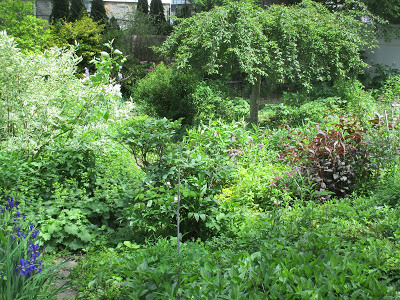 England is a green and flowerful place, and you can credit that otherwise challenging weather for the loveliness of the English countryside and the attractiveness of gardens throughout that country from tiny urban footprints to professionally landscape-curated estates.
England is a green and flowerful place, and you can credit that otherwise challenging weather for the loveliness of the English countryside and the attractiveness of gardens throughout that country from tiny urban footprints to professionally landscape-curated estates.  So while I'm delighted to have some "American" summer weather (even with the current operatic stretch of mid-90s), I'm grateful for that cool, wet growing energy that greened up our world and is in the process of creating a lush, colorful June.
So while I'm delighted to have some "American" summer weather (even with the current operatic stretch of mid-90s), I'm grateful for that cool, wet growing energy that greened up our world and is in the process of creating a lush, colorful June. 
 We lost most of a venerable rhododendron two years ago in the winter that wouldn't stop. The snow kept the ground too cold for too long, apparently, and the upper three quarters of the seeming indestructible plant showed that it was mortal. Other rhodies of a similar type and age in the neighborhood showed some damage, a few died, and the greater number survived virtually untouched. So I'm not sure what lessons are to be learned. Last summer I cut off a lot of the branches I presumed to be dead or too damaged since they weren't sprouting leaves, or the leaves they grew quickly softened, browned and died.
We lost most of a venerable rhododendron two years ago in the winter that wouldn't stop. The snow kept the ground too cold for too long, apparently, and the upper three quarters of the seeming indestructible plant showed that it was mortal. Other rhodies of a similar type and age in the neighborhood showed some damage, a few died, and the greater number survived virtually untouched. So I'm not sure what lessons are to be learned. Last summer I cut off a lot of the branches I presumed to be dead or too damaged since they weren't sprouting leaves, or the leaves they grew quickly softened, browned and died. 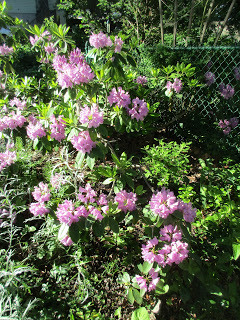
 This year with an oddly, unbalanced looking tree -- tall bare parts, groping lower limbs -- looking like a shipwreck unable to find its way through the ice, we took more radical measures. Anne rented a chainsaw from Home Depot and we attacked the really thick spine of the old tree that I could not cut with hand tools. After a brief chainsaw surgery, some fine-tuning with clippers, and some new fertilized soil, the remaining ground-hugging stories of rhododendron filled their old place in the colorful landscape, though at a reduced height, with fat violet blooms (as seen in the top, third down, and sixth photo down).
This year with an oddly, unbalanced looking tree -- tall bare parts, groping lower limbs -- looking like a shipwreck unable to find its way through the ice, we took more radical measures. Anne rented a chainsaw from Home Depot and we attacked the really thick spine of the old tree that I could not cut with hand tools. After a brief chainsaw surgery, some fine-tuning with clippers, and some new fertilized soil, the remaining ground-hugging stories of rhododendron filled their old place in the colorful landscape, though at a reduced height, with fat violet blooms (as seen in the top, third down, and sixth photo down).
 Taken two weeks ago, the second photo down illustrates the fullness of the verdancy. In the lower left corner of that photo you can see the colony of purple Siberian iris coming into bloom. Iris, named for an Olympian messenger service, sent strongly self-congratulatory signals this year. You see examples of the blossoms in the fourth, fifth and ninth photos. You have to catch them when they're flying those big showy flags of theirs. Most of these blossoms dried and faded under the assault of our 4-day heat wave with temps in the mid-90s. The flag iris plants in the fourth photo have actually moved on to their second round of blooms today.
Taken two weeks ago, the second photo down illustrates the fullness of the verdancy. In the lower left corner of that photo you can see the colony of purple Siberian iris coming into bloom. Iris, named for an Olympian messenger service, sent strongly self-congratulatory signals this year. You see examples of the blossoms in the fourth, fifth and ninth photos. You have to catch them when they're flying those big showy flags of theirs. Most of these blossoms dried and faded under the assault of our 4-day heat wave with temps in the mid-90s. The flag iris plants in the fourth photo have actually moved on to their second round of blooms today. Among other plants looking their best this year is the laurel. A reliable June bloomer, sometimes this plant has suffered from dry conditions, its leaves looking limp and the entire plant less full.
You can see in the whole-plant shot that our laurel -- a family favorite in part because it blooms each year on our daughter Sonya's June birthday -- is in a happy state of bloom (seventh photo). The eighth photo down is a close-up on the pink-highlighted flowers. They're like delicate little cup-shaped vessels for fairy tea parties.
Published on June 13, 2017 15:55
June 5, 2017
The Garden of History: A Novel About Those Who Would Murder Victoria and the Saga of the Boy Who Sought Help From the Queen for His Imperiled Family
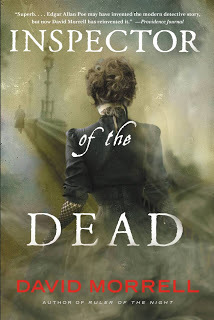 The history is fascinating in this crime novel by popular "thriller" author David Morrell ("Inspector of the Dead," 2015). The book not so much. As those of us who watched the recent Masterpiece TV dramatization of the early years of Queen Victoria's reign know, the queen was the target of an apparent assassination attempt while attempting the then-daring gesture of riding her carriage on a public way. A young man approaches and fires a pistol at Victoria and her husband, Prince Albert. No one is hurt. No 'ball' (bullet) is ever found, and so the apparent assassin cannot be convicted of attempted murder, but is instead locked away in an insane asylum. According to Morrell's book, some witnesses claim that a boy ran up to the carriage attempting to attract the queen's attention just before the assailant fired. A theory emerges: the boy might have been part of the plot, serving to distract attention from the would-be assassin. This story -- shades of the "second assassin" motif in the JFK assassination conspiracy theories -- is the linchpin of Morrell's plot. And this is a book that is all about plot. Here's what I like about "Inspector of the Dead." The author, by his own account, has disappeared "down a rabbit hole" in his fascination with Victorian England -- both the big historical figures, Victoria, politicians, the writer Thomas De Quincey; and the gritty details of slum life and forgotten commercial mores such as the 'doctoring' of beer and gin by pub landlords to cheat customers. Morrell's resurrection of De Quincey is a potentially brilliant move. The author made him a central character in the author's previous Victorian crime novel, "Murder As a Fine Art," based on the "Ratcliffe Murders," an early attempt at the crime pattern now universalized as "the serial killer." To quote from description of this book on Morrell's website: "The Ratcliffe Highway murders of 1811 were the most notorious mass killings in their day. Never fully explained, they brought London and all of England to the verge of panic." Morrell's appropriation of this story places De Quincey and his daughter Emily (who also appears in "Inspector"), in the role of pursuing a Ratcliffe copycat killer who is somehow threatening all of London. Like the superhero novels of comics and cinema, super-detective stories require huge public crises. De Quincey owes his starring role in "Murder" to his "scandalous" Victorian essay based on the Ratcliffe killings titled “On Murder Considered as One of the Fine Arts.” The literary elite loved this wholly amoral ground-breaking take on human behavior. Among those cited its influence are Victorian novelist G.K. Chesterton and 20th century heavyweights Wyndam Lewis and George Orwell. We are also told that De Quincey's intellectual sleuthing influenced Poe (inventor of the detective story), who in turn influenced Conan Doyle (creator of Sherlock Holmes). De Quincy's most famous work was the autobiographical 'novel' (to use the closest term), "Confessions of an Opium-Eater." Generations ahead of his time then, his influence is still under-appreciated today. His book was the first account of the now all too familiar state of drug dependency. In Victorian times doctors prescribed and petty much everybody self-medicated by the use of laudanum, a liquid preparation of opium and a close cousin of morphine and heroin. If you've had surgery (as I have) you know that morphine, still medicine's most widely relied on pain reliever, can give you wicked dreams and what might be described as 'paranoid-delusional states.' De Quincey literally wrote the book on that state of mind as a way of life. Just to round out the picture De Quincey also invented the term "subconscious," and the concept, in his essay "On the Knocking on the Gate in MacBeth." Now given all this deep, fascinating background material to work with, what use does author Morrell make of Thomas De Quincey? He's a slightly swifter Sherlock than other investigators on this case. Sorry, that's it. The book is skin-deep. It's a costume-mystery. Those of us who read it, with at least some enjoyment, are doing so because we like the props. This is probably just another way of saying that "Inspector of the Dead" is commercial fiction. Since I'm drawn to the history, but left lukewarm at best by its 'action-thriller' plot, it's no surprise that the most satisfying part of the book for me was the author's "Afterword," in which he offers such intriguing nuggets as the development of the 'thriller' novel. A product of 19th England, its plots were typically set among the horrors and disasters of other times and other places. What became known as "the sensation novel" emerged in the mid-19th century to imagine terrors taking place in contemporary settings, creating the thrill like that of today's disaster movies or terrorist conspiracy tales. Another genre, called "Newgate novels" (after the infamous prison), told stories of criminal types. Dickens's "Oliver Twist" emerges from this milieu. Since the fiction of "Inspector of the Dead" develops from a theory about the first assassination attempt on Victoria, we also learn from this book that altogether there were seven attempts on her life. The common theme is that they were attempts to gain attention by people whose lives were a misery. That misery has social and economic foundations. Foundations that reach to Lord Who-ha and whoever is residing in Buckingham Palace. But no one was allowed to question the social order in 19th century England. And this novel's character don't either. Morrell's invented story to explain why a poor Irish immigrant boy sought to attract the queen's attention points very strongly to the social, economic and political abuses suffered by the poor. He's trying to save his family from the callous injustice of the legal system. But none of this novel's characters take time from their breathless pursuit of the plot's 'serial' killer to reflect on, or even register, the deeper issue. Neither do the promoters of popular franchises of commercial fiction. The shamelessly pandering blurb on the back cover of "The Inspector of the Dead" claims the book "delves into the heart of evil." It most certainly doesn't. A false accusation of criminality, unexamined by anyone in authority (so Morrell's story tells us), leads directly to the destruction of the four members of our killer's birth family. Now multiply this case by thousands. In the light of this revelation, readers might wish to consider where the true 'heart of evil' resides. But "Inspector" doesn't tempt its readers to these reflections. It wants to get back to the chase. Still, this book makes me want to find the author's 'rabbit hole' and burrow down there for a while myself. For that I can thank David Morrell.
The history is fascinating in this crime novel by popular "thriller" author David Morrell ("Inspector of the Dead," 2015). The book not so much. As those of us who watched the recent Masterpiece TV dramatization of the early years of Queen Victoria's reign know, the queen was the target of an apparent assassination attempt while attempting the then-daring gesture of riding her carriage on a public way. A young man approaches and fires a pistol at Victoria and her husband, Prince Albert. No one is hurt. No 'ball' (bullet) is ever found, and so the apparent assassin cannot be convicted of attempted murder, but is instead locked away in an insane asylum. According to Morrell's book, some witnesses claim that a boy ran up to the carriage attempting to attract the queen's attention just before the assailant fired. A theory emerges: the boy might have been part of the plot, serving to distract attention from the would-be assassin. This story -- shades of the "second assassin" motif in the JFK assassination conspiracy theories -- is the linchpin of Morrell's plot. And this is a book that is all about plot. Here's what I like about "Inspector of the Dead." The author, by his own account, has disappeared "down a rabbit hole" in his fascination with Victorian England -- both the big historical figures, Victoria, politicians, the writer Thomas De Quincey; and the gritty details of slum life and forgotten commercial mores such as the 'doctoring' of beer and gin by pub landlords to cheat customers. Morrell's resurrection of De Quincey is a potentially brilliant move. The author made him a central character in the author's previous Victorian crime novel, "Murder As a Fine Art," based on the "Ratcliffe Murders," an early attempt at the crime pattern now universalized as "the serial killer." To quote from description of this book on Morrell's website: "The Ratcliffe Highway murders of 1811 were the most notorious mass killings in their day. Never fully explained, they brought London and all of England to the verge of panic." Morrell's appropriation of this story places De Quincey and his daughter Emily (who also appears in "Inspector"), in the role of pursuing a Ratcliffe copycat killer who is somehow threatening all of London. Like the superhero novels of comics and cinema, super-detective stories require huge public crises. De Quincey owes his starring role in "Murder" to his "scandalous" Victorian essay based on the Ratcliffe killings titled “On Murder Considered as One of the Fine Arts.” The literary elite loved this wholly amoral ground-breaking take on human behavior. Among those cited its influence are Victorian novelist G.K. Chesterton and 20th century heavyweights Wyndam Lewis and George Orwell. We are also told that De Quincey's intellectual sleuthing influenced Poe (inventor of the detective story), who in turn influenced Conan Doyle (creator of Sherlock Holmes). De Quincy's most famous work was the autobiographical 'novel' (to use the closest term), "Confessions of an Opium-Eater." Generations ahead of his time then, his influence is still under-appreciated today. His book was the first account of the now all too familiar state of drug dependency. In Victorian times doctors prescribed and petty much everybody self-medicated by the use of laudanum, a liquid preparation of opium and a close cousin of morphine and heroin. If you've had surgery (as I have) you know that morphine, still medicine's most widely relied on pain reliever, can give you wicked dreams and what might be described as 'paranoid-delusional states.' De Quincey literally wrote the book on that state of mind as a way of life. Just to round out the picture De Quincey also invented the term "subconscious," and the concept, in his essay "On the Knocking on the Gate in MacBeth." Now given all this deep, fascinating background material to work with, what use does author Morrell make of Thomas De Quincey? He's a slightly swifter Sherlock than other investigators on this case. Sorry, that's it. The book is skin-deep. It's a costume-mystery. Those of us who read it, with at least some enjoyment, are doing so because we like the props. This is probably just another way of saying that "Inspector of the Dead" is commercial fiction. Since I'm drawn to the history, but left lukewarm at best by its 'action-thriller' plot, it's no surprise that the most satisfying part of the book for me was the author's "Afterword," in which he offers such intriguing nuggets as the development of the 'thriller' novel. A product of 19th England, its plots were typically set among the horrors and disasters of other times and other places. What became known as "the sensation novel" emerged in the mid-19th century to imagine terrors taking place in contemporary settings, creating the thrill like that of today's disaster movies or terrorist conspiracy tales. Another genre, called "Newgate novels" (after the infamous prison), told stories of criminal types. Dickens's "Oliver Twist" emerges from this milieu. Since the fiction of "Inspector of the Dead" develops from a theory about the first assassination attempt on Victoria, we also learn from this book that altogether there were seven attempts on her life. The common theme is that they were attempts to gain attention by people whose lives were a misery. That misery has social and economic foundations. Foundations that reach to Lord Who-ha and whoever is residing in Buckingham Palace. But no one was allowed to question the social order in 19th century England. And this novel's character don't either. Morrell's invented story to explain why a poor Irish immigrant boy sought to attract the queen's attention points very strongly to the social, economic and political abuses suffered by the poor. He's trying to save his family from the callous injustice of the legal system. But none of this novel's characters take time from their breathless pursuit of the plot's 'serial' killer to reflect on, or even register, the deeper issue. Neither do the promoters of popular franchises of commercial fiction. The shamelessly pandering blurb on the back cover of "The Inspector of the Dead" claims the book "delves into the heart of evil." It most certainly doesn't. A false accusation of criminality, unexamined by anyone in authority (so Morrell's story tells us), leads directly to the destruction of the four members of our killer's birth family. Now multiply this case by thousands. In the light of this revelation, readers might wish to consider where the true 'heart of evil' resides. But "Inspector" doesn't tempt its readers to these reflections. It wants to get back to the chase. Still, this book makes me want to find the author's 'rabbit hole' and burrow down there for a while myself. For that I can thank David Morrell.
Published on June 05, 2017 18:15
June 1, 2017
The Garden of the Trees: What is that Brown Stringy Stuff Falling From My Oak Tree?
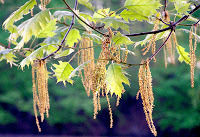 Oak trees have the same unblushing approach to reproduction that characterizes the plant world's expression of all necessary physical functions, including growth, nutrition, birth and death. Green plants do the weirdest things, and you never see them sweat. Oak trees, it turns out, fertilize themselves, having the necessary equipment for both male and female functions. The botanical term for this overdetermined status, according to the sources I have consulted, is "monoecious," an unpronounceable word meaning they produce both male and female flowers. So in the spring, when a green plant's fancy turns to reproduction, oak trees produce male flowers called "staminate" and female flowers called "pistillate," both on their own tree self. These flowers are such modest tints of green, yellow and tan -- unlike the reds and hot pinks and orange and lavender of shameless fruit trees resulting in events such as "cherry blossom time," or the pure alba of the dogwoods -- that you hardly know they are there. Yet quietly in the sturdy, straight-ahead manner characteristic of its kind, the oak gets the job done. The male flowers "grow into a thin, wormlike shape known as a catkin or an ament," according to my source (http://www.ehow.com/about_6465166_do-...). There we have it: "catkins," a word redolent of Victorian drawing classes and a famous love scene in a once-shocking D.H. Lawrence novel called "Women in Love." That 'wormlike' shape has a certain masculine sneakiness to the sound of it. Sure enough catkins consist of "stamens," the male flower part that releases the substance that so troubles allergy sufferers int he spring: pollen. I now know where to look for the cause of the many sneezes that have accompanied this year's early growing season. I recall the word "stamen" as one of those common "parts of a flower," now I know that stamens are in biological cahoots with 'catkins.' OK. Stamens give us pollen, which besides making people go red-eyed and sneezy, comes to rest (according to my source) on "receptive stigma in the female flower." That's pretty blunt. But add this: "with a little help from the wind." Ah, those pandering breezes of spring. So I now know why those light brownish wormlike organic somethings are all over my yard, a fresh supply of them every morning on the 'bistro' table where we breakfast in warm weather under the oak tree. I have been picking them off the upper leaves of plants, just because their pervasive accumulation dulls the color. We're ready to bring this indictment to a close now. The oak tree's female flower -- don't ask me what they look like, but I know they're not long and stringy like catkins -- "grow where the leaf stalks meet the branches or twigs." They are modest and unassuming, I suppose, but in the end they conquer, and endure, hang around all summer, and deliver the goods. Because by summer's end those "receptive stigma" grow into acorns. And here we are in familiar territory. How do these acorns, that we step on on the sidewalk and make that satisfying crunchy sound, come about? Now we know. One last term is introduced as our source informs us that acorns "sit in hard cups called peduncles." So do we all understand now why in a boom year like the current one we have brownish, yellowish tree detritus all over our yards? Well I'll be a monkey's peduncle.
Oak trees have the same unblushing approach to reproduction that characterizes the plant world's expression of all necessary physical functions, including growth, nutrition, birth and death. Green plants do the weirdest things, and you never see them sweat. Oak trees, it turns out, fertilize themselves, having the necessary equipment for both male and female functions. The botanical term for this overdetermined status, according to the sources I have consulted, is "monoecious," an unpronounceable word meaning they produce both male and female flowers. So in the spring, when a green plant's fancy turns to reproduction, oak trees produce male flowers called "staminate" and female flowers called "pistillate," both on their own tree self. These flowers are such modest tints of green, yellow and tan -- unlike the reds and hot pinks and orange and lavender of shameless fruit trees resulting in events such as "cherry blossom time," or the pure alba of the dogwoods -- that you hardly know they are there. Yet quietly in the sturdy, straight-ahead manner characteristic of its kind, the oak gets the job done. The male flowers "grow into a thin, wormlike shape known as a catkin or an ament," according to my source (http://www.ehow.com/about_6465166_do-...). There we have it: "catkins," a word redolent of Victorian drawing classes and a famous love scene in a once-shocking D.H. Lawrence novel called "Women in Love." That 'wormlike' shape has a certain masculine sneakiness to the sound of it. Sure enough catkins consist of "stamens," the male flower part that releases the substance that so troubles allergy sufferers int he spring: pollen. I now know where to look for the cause of the many sneezes that have accompanied this year's early growing season. I recall the word "stamen" as one of those common "parts of a flower," now I know that stamens are in biological cahoots with 'catkins.' OK. Stamens give us pollen, which besides making people go red-eyed and sneezy, comes to rest (according to my source) on "receptive stigma in the female flower." That's pretty blunt. But add this: "with a little help from the wind." Ah, those pandering breezes of spring. So I now know why those light brownish wormlike organic somethings are all over my yard, a fresh supply of them every morning on the 'bistro' table where we breakfast in warm weather under the oak tree. I have been picking them off the upper leaves of plants, just because their pervasive accumulation dulls the color. We're ready to bring this indictment to a close now. The oak tree's female flower -- don't ask me what they look like, but I know they're not long and stringy like catkins -- "grow where the leaf stalks meet the branches or twigs." They are modest and unassuming, I suppose, but in the end they conquer, and endure, hang around all summer, and deliver the goods. Because by summer's end those "receptive stigma" grow into acorns. And here we are in familiar territory. How do these acorns, that we step on on the sidewalk and make that satisfying crunchy sound, come about? Now we know. One last term is introduced as our source informs us that acorns "sit in hard cups called peduncles." So do we all understand now why in a boom year like the current one we have brownish, yellowish tree detritus all over our yards? Well I'll be a monkey's peduncle.
Published on June 01, 2017 19:40
May 28, 2017
The Garden of Spring's Abundance: No Maybes in May
 Coming home last week from a quick visit to New York -- including two perfect weekend days, with irises blossoming in the back lanes between Henry Hudson Parkway and, considerably downgrade, the actual Hudson River, so quiet and lyrically vernal that you can't believe you actually are still in New York City -- we discover that the month of May in Massachusetts has achieved its major statement in our absence.
Coming home last week from a quick visit to New York -- including two perfect weekend days, with irises blossoming in the back lanes between Henry Hudson Parkway and, considerably downgrade, the actual Hudson River, so quiet and lyrically vernal that you can't believe you actually are still in New York City -- we discover that the month of May in Massachusetts has achieved its major statement in our absence. 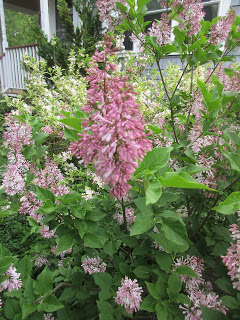 Come on, May, say it with flowers.
Come on, May, say it with flowers. I've been hoping that our streetside lilac bush (or tree; photo at left) would actually blossom in a way that produces the immediate undeniable pleasure of lilac scent. The blossoms have been on the plant for a month, but didn't seem to want to open. And weeks ago we did see and smell lilac blossoms in the abundance of the Arnold Arboretum (in Boston).
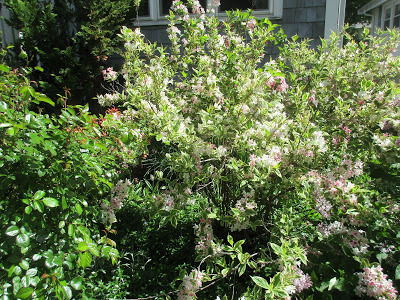
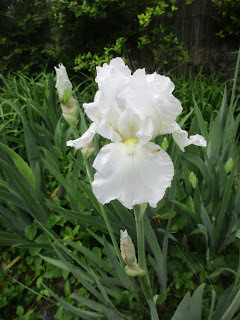 But on returning home Sunday night, we could smell the lilac halfway down the block. This plant is a Korean variety. You can tell the difference at a glance. The Asian lilacs are sold these days as a replacement for the classic New England/New York spring flowering plants, cited by the poets for centuries -- as in Whitman's lament "When lilacs last in the dooryard bloom'd" -- which suffered from disease a few decades back and either died or stopped blooming. You can still see them on old properties. Often you can also see where the old trunks were pruned away in attempts to revive the plant.
But on returning home Sunday night, we could smell the lilac halfway down the block. This plant is a Korean variety. You can tell the difference at a glance. The Asian lilacs are sold these days as a replacement for the classic New England/New York spring flowering plants, cited by the poets for centuries -- as in Whitman's lament "When lilacs last in the dooryard bloom'd" -- which suffered from disease a few decades back and either died or stopped blooming. You can still see them on old properties. Often you can also see where the old trunks were pruned away in attempts to revive the plant.  So, I'm fine with a new approach to lilac -- but hey, we've got a "dooryard" and we've got a lilac in it, so listen to the poet and bloom already.
So, I'm fine with a new approach to lilac -- but hey, we've got a "dooryard" and we've got a lilac in it, so listen to the poet and bloom already.Anyway, this year at least it's worth the wait. An opulent parfumerie.
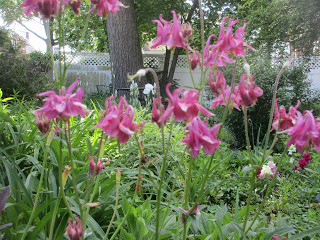 Right beside it is a wiegelia (third pic down), probably too large for the space I have it in, which I've also been expecting to see a bloom. Sympathetically, its blooms opened in rhythm with the lilac, but that means it's getting less attention.
Right beside it is a wiegelia (third pic down), probably too large for the space I have it in, which I've also been expecting to see a bloom. Sympathetically, its blooms opened in rhythm with the lilac, but that means it's getting less attention. And the other thing you notice about all these classic spring perennials, is the bloom while sweet is tragically short.
 The poppies (top photo: orange) lead the way in the quick-show category. We watched the floppy stems reach out with their fat, alien-looking pod-like buds for a couple of weeks. A few finally began opening in the days just before our weekend away, so I said, 'Fine, wait till we go away to do your show. See if I care.'
The poppies (top photo: orange) lead the way in the quick-show category. We watched the floppy stems reach out with their fat, alien-looking pod-like buds for a couple of weeks. A few finally began opening in the days just before our weekend away, so I said, 'Fine, wait till we go away to do your show. See if I care.' 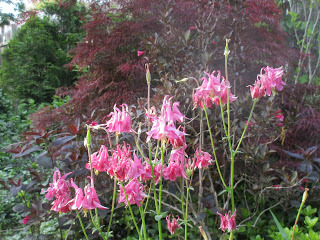 The poppies did open en masse in the two sunny days we were away (I did care). A couple of sunny days dried them out. Then came the latest re-make of spring stormy weather striking the Massachusetts coast. A couple of big rain days to make up for the no rain last spring (and summer) along with some lashing winds. The poppies started dropping their petals. They are all such conformists, these European imports. They bloom at once, blow at at once, decline at once, and wither away. No second acts in poppies. Still, they are a specialty act, a rara avis. And seem to know it.
The poppies did open en masse in the two sunny days we were away (I did care). A couple of sunny days dried them out. Then came the latest re-make of spring stormy weather striking the Massachusetts coast. A couple of big rain days to make up for the no rain last spring (and summer) along with some lashing winds. The poppies started dropping their petals. They are all such conformists, these European imports. They bloom at once, blow at at once, decline at once, and wither away. No second acts in poppies. Still, they are a specialty act, a rara avis. And seem to know it.  And the clematis started climbing. Somehow, thick and rich and darkly purple (fifth photo down) in the blossoming, the plant forgot how to pull itself up on the dried-out vines from last year's climbing days and fell to rolling around on its own new exuberant growth. I found enough string to attach one of the most vigorous vines to the porch railing. I figured I would tie each of the others in turn, but a couple of fast-growing days later found to my happy surprise that the other vines had shot upward and latched on to the porch rails on their own. Good clematis; getting smarter every year.
And the clematis started climbing. Somehow, thick and rich and darkly purple (fifth photo down) in the blossoming, the plant forgot how to pull itself up on the dried-out vines from last year's climbing days and fell to rolling around on its own new exuberant growth. I found enough string to attach one of the most vigorous vines to the porch railing. I figured I would tie each of the others in turn, but a couple of fast-growing days later found to my happy surprise that the other vines had shot upward and latched on to the porch rails on their own. Good clematis; getting smarter every year. I've also been watching the columbine blossoms sit coolly in some demi-monde state, not quite the lush dark-pink performers I recalled from other years (sixth and eighth photos down). Clearly, the only problem was my impatience. They plumped up into shapely forms, tumbling upside-down trumpets of descending posture and tone.
As for the irises (fourth and bottom photos), I have no schedule for them, though I think of them as a June bloomer. Depends on the climate, probably, and the earliness or lateness of any given spring. Late May has triggered these white blooms. A very classical shape. You can say only that it looks like nothing else but what it is: Iris. Named for the "personification of the rainbow" and the messenger of the gods.
The message of the gods seems pretty clear these days: spring beauty.
Published on May 28, 2017 15:48
May 23, 2017
The Garden of Literary History: The Mind of England, and the Pen of Shakespeare, When James I Wore Two Crowns
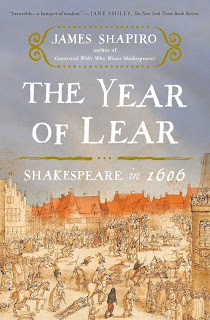 What else don't we know about "history"? Every time I pick up a book as well-written, researched and formulated as "The Year of Lear: Shakespeare in 1606," I walk around in a cloud of 'wow, imagine that, who would have known such-and-such?' Shakespearean scholars as learned as "The Year of Lear" author James Shapiro (how wide a set that can be?) seem to know a lot more about the circumstances in which his plays were written than they did a few decades ago when I was studying them in graduate school. We were certainly aware that the change from the Elizabethan period to the Stuart dynasty upon the ascension of James I to the throne of England in 1603 had consequences for Shakespeare and his crew. But "The Year of Lear" tracks the composition of three of Shakespeare's major tragic masterpieces against the pulses of the news cycle in the fraught transitional year of 1606. A number of strong political, cultural and religious forces buffeted English society in the years immediately after Elizabeth's death. Her death marked the end of an era when England took its place as a central player on the world (i.e. European) stage, fending off attempts at domination by larger powers just as 'Good Queen Bess' fended off marriage proposals from Spain and France. I think Shakespeare's history plays and other formative successes in the Elizabethan theater may have helped build a sense of a shared, significant national culture -- though Shapiro's book does not make this point. England now possessed an art through which to know itself. France and Italy had music and art. Spain had wealth; along with its own literary tradition of the "picaro" (or picaresque tale) that flowered in Cervantes, Shakespeare's contemporary and, in many eyes, peer. England fought off a Spanish invasion during Elizabeth's reign and sent its first expeditions to compete in the great game of exploration, world trade, and eventual colonization. On the home front it stabilized as a Protestant nation with a clearly outlined, though limited tolerance for Catholics. London became a teeming, populous, international trade center and world capital. But following the queen's death, the plague returned to London with the first warm season, after a few years of happy absence. James avoided the city like the -- well, thing in itself -- and his coronation was put off for two years. Parliament was reluctant to meet. The theaters were closed; "The Year of Lear" reports that the city had a law closing the theaters whenever the official "death list" from plague reached 30 in a week. Astonishing facts of a long-ago, but literate civilization: London kept a list of everybody who died from plague, though some of these records were lost in a later fire. Still Shapiro can tell us that Shakespeare's London landlady died in the plague at this time and that she was close enough to her prominent lodger to ask him to help arrange a marriage for her daughter. Records show this. Because of the epidemics, the king's absence from London, and the uncertainties of how to please the new regime, Shakespeare's company virtually shut down and -- astonishingly -- he wrote no new plays for two or three years after a decade of regular production of brilliant new work. From my studies I knew that "Lear," "MacBeth," and "Antony and Cleopatra" are considered the 'later tragedies,' but little of their circumstances. They were 'later,' I know now, because there were no outdoor, public theaters for 'The King's Men' to perform in, and no king in London to commission new works from the company to debut before him. When James finally settled in and new works were called for, several major social and political forces helped light a fire and provide the tender in the imagination of the world's greatest playwright. For me, this is the deeper insight that "The Year of Lear" offers about the nature of great public art, particularly of the literary and narrative sort: The problems of a given society feed the juices of great imaginations; their productions in turn nourish the ruminations of the people. The big issue dominating the early years of James Stuart's reign was his desire to merge the two kingdoms of England and Scotland into one united kingdom since he was now monarch of both. James was a proponent of the "divine right" of monarchs. Since God (he reasoned) had made him king of both lands, God clearly wanted them united. Furthermore, James dusted off an old legend that the two countries used to be one kingdom since they share the same geographical entity. God not only works in mysterious ways, apparently, he works in islands. In fact, an old play based on a British legend depicted the terrible consequences of an aging king's decision to divide his kingdom. This story of course is "King Leir," which Shakespeare re-imagined as "King Lear." While a lot more is going on in Lear besides dynastic politics, Shapiro is clearly onto something when he points out that a play warning of the dangers of dividing a kingdom would likely find favor with a king who wanted to unite his two crowns to form Great Britain. "The Year of Lear" also mulls the play's (highly unpopular) innovation of failing to offer a restorative happy ending to bring a troubled world back to rights. Shapiro provides the intriguing suggestion that the play's last lines spoken by Edgar, a member of the younger generation, "we that are young / shall never see so much nor live so long" as the previous generation, amount to a valedictory for Elizabeth's epic reign. Audiences are so troubled by the death of the "good" daughter, Cordelia, that subsequent productions consistently brought her back to life. My suggestion on the playwright's unconventional choice: Might not Cordelia's death stand in for the thousands of innocents slaughtered by London's plagues? When London finally appeared safe enough for James to make his court there and press Parliament to approve an "act of unification" of the two kingdoms, his new country is faced with an act of treachery that shakes it to the roots. In November of 1605, England endured a near-miss 911-sized catastrophe known to history as the Gunpowder Plot. An explosive attempt at a stroke of terrorism meant to destroy, king, royal family, government and much of the ruling class in a single cataclysm produced by tons of gunpowder and musket shot stored in the bowels of Parliament. 'Security' had a long way to go back then; the conspirators had simply rented the basement storage areas from the government. The plot was also intended to set off a nationwide Catholic uprising to restore the "old religion," return the country to the authority of the Roman Catholic church, and install a Catholic monarch. Of further import to our story, many of the plotters had connections to the region of Shakespeare's own Stratford. How big a deal this plot -- reduced in current days to the devilry of "Guy Fawkes Day" -- was for post-Elizabethan England is recounted in greater legal and political detail than I needed. What I will remember is that the repressive laws against Catholics enacted in the wake of this plot swept up Shakespeare's daughter, who initially refused to swear a new 'loyalty' oath but was forced to recant. Shapiro make the connection between this near-disaster both to Lear and, more importantly, to MacBeth, a play about the treasonous murder of a Scottish king. Again, I think there's a deeper take-away. Tragedy was invented in Ancient Greece from the politically driven need for a citizenry to experience, at artistic remove, the disasters that befall those who seek to rule. Greek tragedy is about power, rule, and passion. We the people cram into the amphitheater to feel the terror of crime, misdeed, and failure. We fear the terror of failure and crime; we find compassion in our own hearts for the human suffering displayed for us on stage. MacBeth is also a cautionary tale. What would happen if a plot to kill a king succeeded? -- as MacBeth's plot to kill Duncan does, and as the Gunpowder Plot to kill James I failed to. What happens is you get MacBeth, "in blood stepped in so far" that a nation must suffer more wars and the bloody removal of another king before the moral order is restored. MacBeth is also, Shapiro argues, a play about "equivocation," which James's England considered as bad armed rebellion. To them equivocation meant not telling the whole truth when you are put under oath to do just that -- as the courtroom oath says today, you swear "to tell the truth and the whole truth." If rebels, traitors -- particularly secret Catholics -- believed it was all right in God's eyes to hold back part of the truth from a courtroom or any official inquiry, then society would fall apart. You would never know who to believe. Hence in MacBeth we have witches telling newly elevated war hero MacBeth what he wants to hear in his secret heart, but only hinting, or perhaps omitting entirely, important pieces of the story. Shapiro closely analyzes a playful of other examples of 'equivocation,' of giving a misleading or partial impression. Oh, dear, it's everywhere. I'm afraid Shakespeare's day never knew the half of it. Today American citizens routinely listen to their elected leaders and come away saying, "Ah, they're all lying. That's what they do." Frankly, I suspect we all hold back some of the truth. I'm afraid I'm holding back any discussion of "Anthony and Cleopatra," the third of the great tragedies Shapiro finds bathed in the controversial waters of 1606, because it's a play I've never warmed up to. Also because the author's case for relating this play to specific events and the national mood at the time of its writing is too subtle for summation here. Besides, I've already forgotten so much of this argument that I need to read it again. But this is the beauty of reading history, especially when important times and great writers intersect. The truth is, there is always something new under the sun. It's the old stuff we never knew.
What else don't we know about "history"? Every time I pick up a book as well-written, researched and formulated as "The Year of Lear: Shakespeare in 1606," I walk around in a cloud of 'wow, imagine that, who would have known such-and-such?' Shakespearean scholars as learned as "The Year of Lear" author James Shapiro (how wide a set that can be?) seem to know a lot more about the circumstances in which his plays were written than they did a few decades ago when I was studying them in graduate school. We were certainly aware that the change from the Elizabethan period to the Stuart dynasty upon the ascension of James I to the throne of England in 1603 had consequences for Shakespeare and his crew. But "The Year of Lear" tracks the composition of three of Shakespeare's major tragic masterpieces against the pulses of the news cycle in the fraught transitional year of 1606. A number of strong political, cultural and religious forces buffeted English society in the years immediately after Elizabeth's death. Her death marked the end of an era when England took its place as a central player on the world (i.e. European) stage, fending off attempts at domination by larger powers just as 'Good Queen Bess' fended off marriage proposals from Spain and France. I think Shakespeare's history plays and other formative successes in the Elizabethan theater may have helped build a sense of a shared, significant national culture -- though Shapiro's book does not make this point. England now possessed an art through which to know itself. France and Italy had music and art. Spain had wealth; along with its own literary tradition of the "picaro" (or picaresque tale) that flowered in Cervantes, Shakespeare's contemporary and, in many eyes, peer. England fought off a Spanish invasion during Elizabeth's reign and sent its first expeditions to compete in the great game of exploration, world trade, and eventual colonization. On the home front it stabilized as a Protestant nation with a clearly outlined, though limited tolerance for Catholics. London became a teeming, populous, international trade center and world capital. But following the queen's death, the plague returned to London with the first warm season, after a few years of happy absence. James avoided the city like the -- well, thing in itself -- and his coronation was put off for two years. Parliament was reluctant to meet. The theaters were closed; "The Year of Lear" reports that the city had a law closing the theaters whenever the official "death list" from plague reached 30 in a week. Astonishing facts of a long-ago, but literate civilization: London kept a list of everybody who died from plague, though some of these records were lost in a later fire. Still Shapiro can tell us that Shakespeare's London landlady died in the plague at this time and that she was close enough to her prominent lodger to ask him to help arrange a marriage for her daughter. Records show this. Because of the epidemics, the king's absence from London, and the uncertainties of how to please the new regime, Shakespeare's company virtually shut down and -- astonishingly -- he wrote no new plays for two or three years after a decade of regular production of brilliant new work. From my studies I knew that "Lear," "MacBeth," and "Antony and Cleopatra" are considered the 'later tragedies,' but little of their circumstances. They were 'later,' I know now, because there were no outdoor, public theaters for 'The King's Men' to perform in, and no king in London to commission new works from the company to debut before him. When James finally settled in and new works were called for, several major social and political forces helped light a fire and provide the tender in the imagination of the world's greatest playwright. For me, this is the deeper insight that "The Year of Lear" offers about the nature of great public art, particularly of the literary and narrative sort: The problems of a given society feed the juices of great imaginations; their productions in turn nourish the ruminations of the people. The big issue dominating the early years of James Stuart's reign was his desire to merge the two kingdoms of England and Scotland into one united kingdom since he was now monarch of both. James was a proponent of the "divine right" of monarchs. Since God (he reasoned) had made him king of both lands, God clearly wanted them united. Furthermore, James dusted off an old legend that the two countries used to be one kingdom since they share the same geographical entity. God not only works in mysterious ways, apparently, he works in islands. In fact, an old play based on a British legend depicted the terrible consequences of an aging king's decision to divide his kingdom. This story of course is "King Leir," which Shakespeare re-imagined as "King Lear." While a lot more is going on in Lear besides dynastic politics, Shapiro is clearly onto something when he points out that a play warning of the dangers of dividing a kingdom would likely find favor with a king who wanted to unite his two crowns to form Great Britain. "The Year of Lear" also mulls the play's (highly unpopular) innovation of failing to offer a restorative happy ending to bring a troubled world back to rights. Shapiro provides the intriguing suggestion that the play's last lines spoken by Edgar, a member of the younger generation, "we that are young / shall never see so much nor live so long" as the previous generation, amount to a valedictory for Elizabeth's epic reign. Audiences are so troubled by the death of the "good" daughter, Cordelia, that subsequent productions consistently brought her back to life. My suggestion on the playwright's unconventional choice: Might not Cordelia's death stand in for the thousands of innocents slaughtered by London's plagues? When London finally appeared safe enough for James to make his court there and press Parliament to approve an "act of unification" of the two kingdoms, his new country is faced with an act of treachery that shakes it to the roots. In November of 1605, England endured a near-miss 911-sized catastrophe known to history as the Gunpowder Plot. An explosive attempt at a stroke of terrorism meant to destroy, king, royal family, government and much of the ruling class in a single cataclysm produced by tons of gunpowder and musket shot stored in the bowels of Parliament. 'Security' had a long way to go back then; the conspirators had simply rented the basement storage areas from the government. The plot was also intended to set off a nationwide Catholic uprising to restore the "old religion," return the country to the authority of the Roman Catholic church, and install a Catholic monarch. Of further import to our story, many of the plotters had connections to the region of Shakespeare's own Stratford. How big a deal this plot -- reduced in current days to the devilry of "Guy Fawkes Day" -- was for post-Elizabethan England is recounted in greater legal and political detail than I needed. What I will remember is that the repressive laws against Catholics enacted in the wake of this plot swept up Shakespeare's daughter, who initially refused to swear a new 'loyalty' oath but was forced to recant. Shapiro make the connection between this near-disaster both to Lear and, more importantly, to MacBeth, a play about the treasonous murder of a Scottish king. Again, I think there's a deeper take-away. Tragedy was invented in Ancient Greece from the politically driven need for a citizenry to experience, at artistic remove, the disasters that befall those who seek to rule. Greek tragedy is about power, rule, and passion. We the people cram into the amphitheater to feel the terror of crime, misdeed, and failure. We fear the terror of failure and crime; we find compassion in our own hearts for the human suffering displayed for us on stage. MacBeth is also a cautionary tale. What would happen if a plot to kill a king succeeded? -- as MacBeth's plot to kill Duncan does, and as the Gunpowder Plot to kill James I failed to. What happens is you get MacBeth, "in blood stepped in so far" that a nation must suffer more wars and the bloody removal of another king before the moral order is restored. MacBeth is also, Shapiro argues, a play about "equivocation," which James's England considered as bad armed rebellion. To them equivocation meant not telling the whole truth when you are put under oath to do just that -- as the courtroom oath says today, you swear "to tell the truth and the whole truth." If rebels, traitors -- particularly secret Catholics -- believed it was all right in God's eyes to hold back part of the truth from a courtroom or any official inquiry, then society would fall apart. You would never know who to believe. Hence in MacBeth we have witches telling newly elevated war hero MacBeth what he wants to hear in his secret heart, but only hinting, or perhaps omitting entirely, important pieces of the story. Shapiro closely analyzes a playful of other examples of 'equivocation,' of giving a misleading or partial impression. Oh, dear, it's everywhere. I'm afraid Shakespeare's day never knew the half of it. Today American citizens routinely listen to their elected leaders and come away saying, "Ah, they're all lying. That's what they do." Frankly, I suspect we all hold back some of the truth. I'm afraid I'm holding back any discussion of "Anthony and Cleopatra," the third of the great tragedies Shapiro finds bathed in the controversial waters of 1606, because it's a play I've never warmed up to. Also because the author's case for relating this play to specific events and the national mood at the time of its writing is too subtle for summation here. Besides, I've already forgotten so much of this argument that I need to read it again. But this is the beauty of reading history, especially when important times and great writers intersect. The truth is, there is always something new under the sun. It's the old stuff we never knew.
Published on May 23, 2017 20:14
May 21, 2017
The Garden of the Seasons: Little Pleasures of Spring
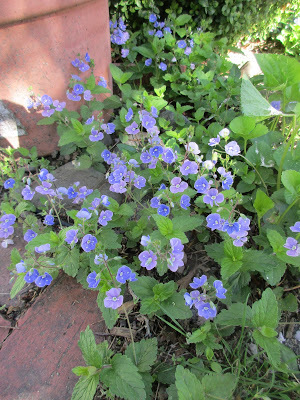 The first weeks of May are the best of times in many ways. Including the pleasure of looking closely for that fine class of small blossoms that grow close to the ground on plants that hug the earth and take their share of sunlight before the bigger boys grow over them and tend to hog it all.
The first weeks of May are the best of times in many ways. Including the pleasure of looking closely for that fine class of small blossoms that grow close to the ground on plants that hug the earth and take their share of sunlight before the bigger boys grow over them and tend to hog it all.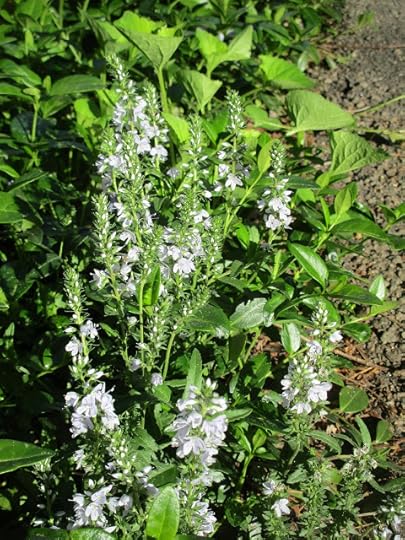 One of these ground huggers (or 'covers') blossoms with the abundance of tiny purple circlets you see in the top photo. I have never been able to learn their name. Recently, the suggestion "Pennyroyal" was offered. Nothing I can find online has put the matter to rest for me.
One of these ground huggers (or 'covers') blossoms with the abundance of tiny purple circlets you see in the top photo. I have never been able to learn their name. Recently, the suggestion "Pennyroyal" was offered. Nothing I can find online has put the matter to rest for me.  Speedwell is another all-purpose name. Plants sold under that name include those in the second photo down, showing vertical stalks with lines of trumpet-shaped pale blue blossoms. But also the significantly different plant structure seen in the second to last photo on this page. A dense scatter of single blossom, again a light blue, among attractively shaped leaves.
Speedwell is another all-purpose name. Plants sold under that name include those in the second photo down, showing vertical stalks with lines of trumpet-shaped pale blue blossoms. But also the significantly different plant structure seen in the second to last photo on this page. A dense scatter of single blossom, again a light blue, among attractively shaped leaves. 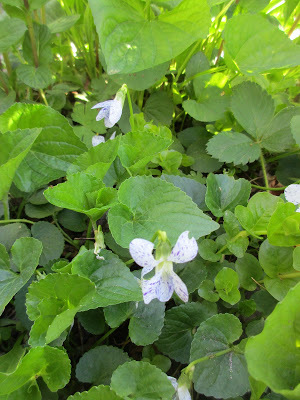
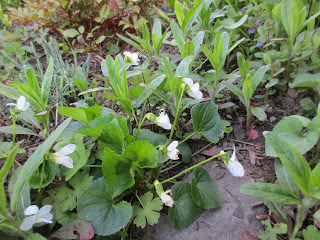 The third photo down pictures a patch of lily of the valley with spear shaped leaves mixed in among the low mass of sweet woodruff. Both of these plants produce delicate white blossoms. The lilies blossom a single stalk with tiny bell-shaped flowers. The mat of white flowers of the sweet woodruff are shown in the sixth photo down.
The third photo down pictures a patch of lily of the valley with spear shaped leaves mixed in among the low mass of sweet woodruff. Both of these plants produce delicate white blossoms. The lilies blossom a single stalk with tiny bell-shaped flowers. The mat of white flowers of the sweet woodruff are shown in the sixth photo down. Common violets range in color from dark purple to light violet to the nearly white flowers with purple spots pictured in two photos here.
Another prolific low growing, blue flowering, ground covering plant is the Forget-me-not, seen below growing amid the spear-shaped leaves of daffodils and daylilies.
 The last photo in this group, and the only one with pink flowers is the low phlox which truly illustrate the concept of "ground cover" for a few weeks each spring.
The last photo in this group, and the only one with pink flowers is the low phlox which truly illustrate the concept of "ground cover" for a few weeks each spring. 


Published on May 21, 2017 21:46



